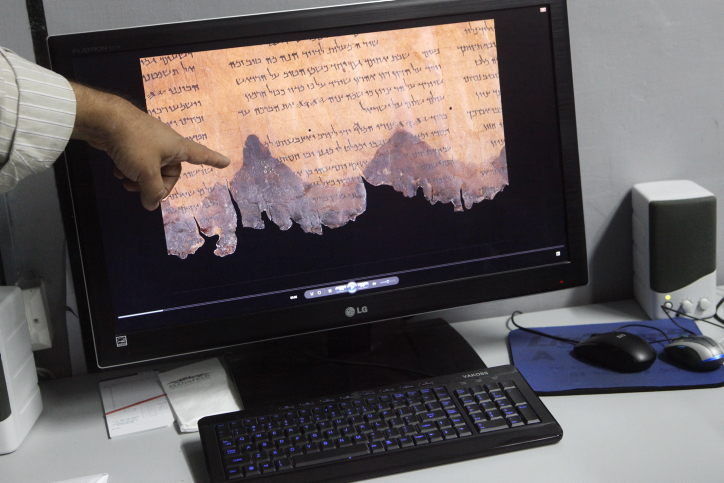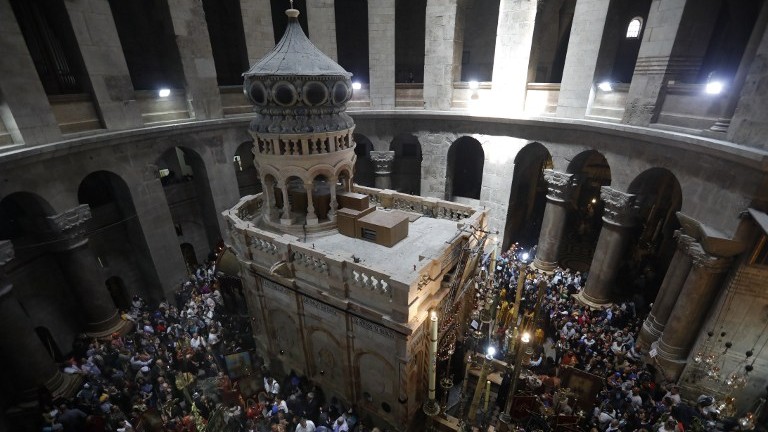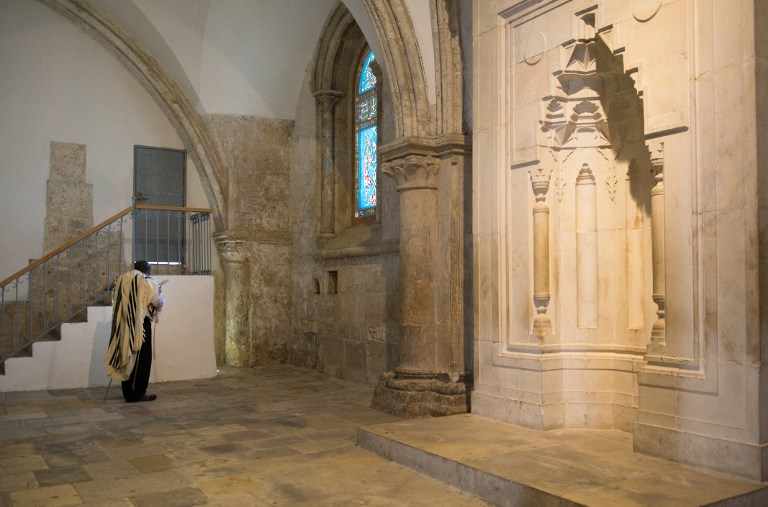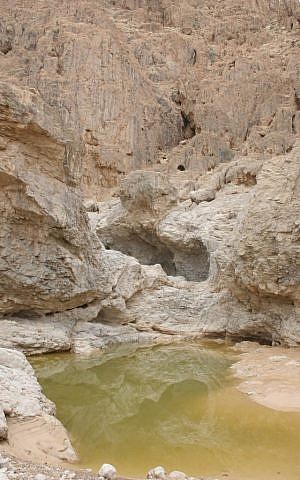Review of Mind the Gap by Matthias Henze
When Rice University organized religion professor Matthias Henze visits local Houston-area churches and synagogues to promote interfaith understanding betwixt Christianity and Judaism, he focuses on discussing one item time flow: the 4-to-five-century gap between the Erstwhile and New Testaments.
"It's been overlooked for a number of reasons," said Henze, a scholar of the Hebrew Bible and early on Judaism, with an emphasis on the Second Temple. "Both Jews and Christians don't pay much attending to this flow."
Co-ordinate to Henze, the "gap centuries" betwixt the fourth century BCE and the first century CE are crucial to understanding that in that location may exist less of a chasm between the two religions than many people might call back. He contends that Hebrew religious texts from this period, including the Expressionless Bounding main Scrolls, helped influence Jesus, whom he describes equally a Jew who practiced the Judaism of his day.

Rice University religion professor and writer of 'Listen the Gap,' Matthias Henze. (Courtesy)
This argument is alluded to in the subtitle to his new book, "Mind the Gap: How the Jewish Writings Between the Old and New Testament Aid Us Empathize Jesus."
With an awareness of Hebrew religious texts from the gap years, "Jesus now has a context," Henze said. "We put him where he belongs. He's no longer a grapheme past himself, he'southward no longer sporadic."
And, he said, "one time nosotros sympathise Jesus as part of a larger Jewish earth, I think nosotros're doing much more justice to the New Attestation."
Sides of a money
Henze is a veteran of interfaith outreach. A Lutheran from Hanover, Frg, he is the director of Rice's Jewish studies department, which he founded in 2009.
"I have a long deep-seated interest in Judaism and Jesus history, and certainly the Hebrew language," Henze said.

'Mind the Gap,' by Matthias Henze. (Courtesy)
This prepared him well when discussing Judaism and Christianity at local religious institutions.
"I'thousand very comfortable giving talks in churches about Jewish issues, building community," Henze said. "People desire to talk virtually Christianity, particularly nigh Jesus. They have a great desire to learn more about the origins of Christianity, the early Jesus motility."
This made information technology central to understand the gap years — roughly speaking, "the latter part of the Second Temple period," Henze wrote in an email.
The gap began after the last books in the Sometime Attestation were written in the fourth century BCE (the solitary exception is the Book of Daniel, from the 2d century BCE). Closing the gap, the New Testament was written in the second half of the get-go century CE.
"My thesis is that in the gap," Henze said, "Jews felt gratuitous to write new texts, think new thoughts, develop new literary forms of expression."
It was a time when the kingdoms of State of israel and Judah were ruled, successively, by the Persians, Greeks, Hasmoneans and Romans — with only the Hasmoneans, the Maccabean dynasty, representing domestic rule.
At the end of the period, Henze said, Jews bravely tried out new ideas, and "Christianity emerges… Jesus comes forth, the inheritor of those ideas."
But this was followed past retributive acts — the crucifixion of Jesus and the destruction of the 2d Temple. The by and large accustomed date of Jesus's crucifixion is betwixt xxx and 33 CE. The 2nd Temple fell in seventy CE.
The Dead Sea Scrolls, compiled by the Essene community at Qumran, are amid the best-known Hebrew religious texts from the gap flow. Henze cites others also.

The State of war Scroll, institute in Qumran Cavern one. (Public domain)
The Septuagint, or the Greek translation of the Tanakh, includes the Apocrypha, which Henze called "a well-divers list of certain aboriginal Jewish books" not plant in the Hebrew Bible, such as Tobit, Judith, and 1 and two Maccabees.
Other, older Jewish texts from the same fourth dimension menstruum, or slightly before, were not part of a fixed list and were designated the Pseudepigrapha, a Greek term meaning "written under a pseudonym," Henze said. In this case, "they were written under the proper name of an aboriginal Bible figure."
He mentioned i Enoch, which evokes "a grapheme mentioned in Genesis 5, a very important effigy for Jews in the tertiary and second centuries BCE," besides as the Volume of Jubilees, "a Jewish book from the second century BCE retelling the Volume of Genesis and Exodus."
A product of his times
Collectively, said Henze, these works shed light upon Jesus's Judaism.
"We open up the New Testament and find Jesus equally part of the Judaism of his solar day," Henze said. "He was a Jew, born in Israel of Jewish parents, raised [there], presented to the Temple, died Jewish."
But the Judaism of Jesus'southward day often differs from that of the Old Testament.
"In the New Testament, Jesus goes to synagogue in Luke iv, 'as was his custom,' on the Sabbath mean solar day. There are no synagogues in the Old Testament, the Hebrew Bible," Henze said.
"Jesus being called 'rabbi' by his disciples. There are no rabbis in the Tanakh. Jesus spends much of his fourth dimension discussing Torah and the Pharisees, as every Christian knows. At that place are no Pharisees in the Tanakh. Resurrection is said to be the finish of life. It's not in the Hebrew Bible except the Book of Daniel, the last in the Bible."

Illustrative: A worker of the Israel Antiquities Dominance points to a spectral prototype photograph of fragments of the Dead Sea scrolls, at the Israel Museum in Jerusalem. December xviii, 2012. (photo credit: Miriam Alster/Flash90)
Henze said "that when Christians read this and plow to the Former Testament, and there are no texts that explain it, they assume Jesus was really breaking with everything. … The argument of the volume is that yes, information technology is extraordinary, but only if all you lot read is the Sometime Testament. We're overlooking that Jesus was part of a Judaism derived farther from the Hebrew Bible."
To make his case, Henze focuses on what he describes equally four big topics of early Christianity: "Messianism; demons and unclean spirits — a living globe densely populated with angels and demons; Torah, its significance and correct interpretation; and the belief in resurrection or life over expiry, life with angels."
"Yep, they come from the Quondam Attestation," he said. "But they are not really fully anticipated in the One-time Attestation. They were more systematic, from the very rich literature that followed the Former Testament and predates the New Testament."
The idea of Jesus every bit the messiah of Israel arose from "the expectation of a messiah at the finish of days, history as nosotros know it, an agent of God, moshiach [the messiah]," he said. "It's a kind of matter not found in the Tanakh per se."

Christian Orthodox communities nourish the Palm Sunday Easter procession at the Church building of the Holy Sepulchre in Jerusalem's Old City on Apr nine, 2017. (AFP Photo/Gali Tibbon)
But, he said, "there are a number of texts, primarily from the Expressionless Ocean Scrolls, nearly early Jewish messianic expectations comparable with the description of Jesus in the gospels. Information technology'southward obvious that the gospel writer was trying to brand a case that Jesus is the messiah for whom Israel has waited, terms that would have been familiar with Jewish audiences."
And he said that while "resurrection was so central to early Christianity at the time, there was no conventionalities in resurrection of the dead in the Tanakh," except for in the Book of Daniel at the end of the Second Temple period.
"In between the Old and New Attestation, a number of Jewish texts talk about resurrection, life in the company of angels. We need to understand it in the context of other Jewish texts," said Henze.
A riveting chronology
Fellow scholars find Henze'south arguments intriguing — with caveats.
"The sources for our [understanding] of Jesus are circuitous," said Notre Matriarch acquaintance professor David Lincicum, who focuses on biblical studies and Christianity and Judaism in artifact, and who is collaborating on a project with Henze. "It'south not clear what kind of education [Jesus] had.
"I feel it's fair to say that a lot of the [Hebrew 'gap'] texts reverberate discussions in the air in the commencement century. The Apocrypha seem to take been widespread in early Judaism. There was a knowledge of outside texts," Lincicum said.

Kind David'due south Tomb and the cenacle, believed to be the site of the Last Supper, are housed in the same building on Mount Zion. (Shmuel Bar-Am)
And "while the Hebrew Bible is relatively silent on a messiah, [after the topic becomes] familiar, all of a sudden everybody talks messiah. At that place are gaps in the Judaism that develops. In some strands, there's an anointed figure to save Israel. Information technology might not be that Jesus knows a item text, merely information technology might adjure a broader mainstream that he otherwise might not have admission to," he said.
However, Darrell L. Bock, executive director of cultural date and senior research professor of New Testament studies at Dallas Theological Seminary, cautions against overemphasizing the gap centuries.
For example, Bock said that only because rabbis "don't emerge in a significant kind of way until the centrality of the Temple is lost, the destruction of the Temple, does not hateful there were no rabbis.
"Be careful about [calling rabbis an] anachronism," he said. Bock's noesis of Jesus is possibly best-known from his 2004 bestseller "Breaking the Da Vinci Code: Answers to the Questions Everyone's Asking."
He also noted that the developments of the gap flow might not have been caused exclusively past religious factors, but by political and social ones likewise.

The Cenacle, or Upper Room, on Mount Zion but exterior the Old Urban center, where Christians believe Jesus held the Terminal Supper, is revered by Jews every bit the site of Rex David'southward tomb. (photograph credit: AFP/Constance Decorde)
The biblical Israel was "in control of the political and social situation in [the] land," Bock said. "That was non the case in the time of Jesus. Greco-Roman influence was omnipotent, pervasive. These differences make a big deal. Concepts are adult — the messiah, a promise, a render to the effective dynastic dominion of the One-time Attestation.

A natural pool forth the ancient Qumran cliffs (photo credit: Shmuel Bar-Am)
"There is a focus on the messianic cult, in inter-testamental texts, that will choice upwards hope and vindicate. Jesus puts himself as the messiah for not but State of israel. He also concentrates on how others are treated as well. Information technology's similar on one hand and distinct on the other," said Bock.
Bock told The Times of Israel that Jesus ends upward differing from all of the groups of his mean solar day — Sadducees and Pharisees, Essenes and Zealots.
"I recall Jesus hoped that he would exist somewhat distinctive from the variety of approaches," Bock said. "He developed a tradition that reacted to some degree against all those groups."
Bock did concur that "Jesus did not come into a vacuum. He did not do it every bit a Jew who walked away from everything that being Jewish embodied. Conspicuously, Jesus thought independently of things — Jewish tradition, that kind of affair."

Greek Orthodox worshipers hold a palm fond in the Church building of the Holy Sepulcher, traditionally believed past many to be the site of the crucifixion and burial of Jesus Christ during Orthodox Palm Sunday, in Jerusalem, Sun, Apr 5, 2015. (photo credit: AP/Ariel Schalit)
What would Jesus think
Whether one agrees or disagrees with Henze, the author hopes to encourage independent thinking with his volume — including in its concluding section.

Rice University religion professor and author of 'Mind the Gap,' Matthias Henze. (Courtesy)
"I pose a few challenges to Christian readers," he said. "How does our agreement of Jesus and the New Attestation alter if we have seriously that Jesus was a Jew?"
"Many Christians believe that Jesus is exactly like them, the aforementioned theology, he looked like you, he was the same denomination and lived in first-century Israel," said Henze.
Henze calls for Christians to go more familiar with Judaism — that of their neighbor's today, and also the ii,000-year-one-time version practiced by Jesus and other Jews of his era.
Henze hopes that all readers regardless of their religion will "become open to the possibility of historical and religious context" and "read the New Testament in a more responsible, informed way."
"My hope for the volume is that it will find a wide readership and people volition start to rethink what they thought they had known," he said.
pentecosttoges1940.blogspot.com
Source: https://www.timesofisrael.com/jesus-was-more-jewish-than-you-think-says-bible-prof/
0 Response to "Review of Mind the Gap by Matthias Henze"
إرسال تعليق